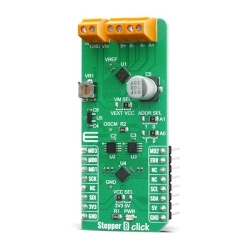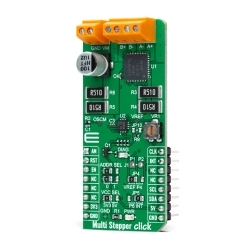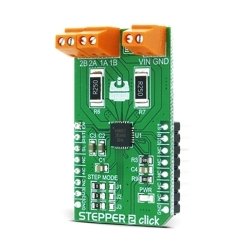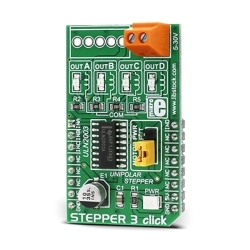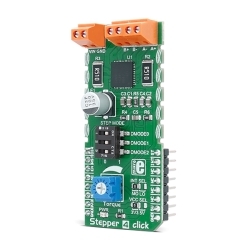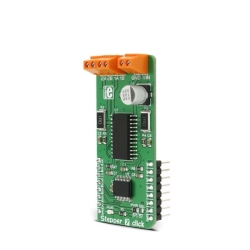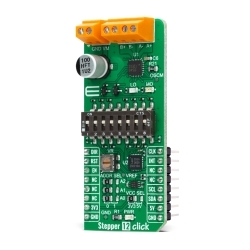MIKROE Multi Stepper Click - TB67S261
Multi Stepper Click is a compact add-on board that contains a bipolar stepper motor driver.
Product Overview
Multi Stepper Click is a compact add-on board that contains a bipolar stepper motor driver. This board features the TB67S261FTG, a PHASE-in controlled bipolar stepping motor driver from Toshiba Semiconductor. It supports a PWM constant-current control drive and full-, half-, and quarter-step operation for less motor noise and smoother control. It has a wide operating voltage range of 10V to 47V with an output current capacity of 1.4A in addition to several built-in error detection circuits. This Click board™ makes the perfect solution for stepping motors in various applications such as office automation, commercial, and industrial equipment.
Multi Stepper Click is supported by a mikroSDK compliant library, which includes functions that simplify software development.
Multi Stepper Click as its foundation uses the TB67S261FTG, a two-phase bipolar stepping motor driver using a PWM chopper (customized by external resistance R2 and capacitor C1) from Toshiba Semiconductor. The TB67S261FTG incorporates a low on-resistance MOSFET output stage, which can deliver a 1.4A current with a motor output voltage rating of 47V, in addition to integrated protection mechanisms such as over-current and over-temperature detection. In addition, it supports full-, half-, and quarter-step resolution, with the help of which motor noise can be significantly reduced with smoother operation and more precise control.
As mentioned in the product description, this stepping motor driver is PHASE-in controlled. These control signals are provided through the PCA9555A port expander, which establishes communication with the MCU via the I2C serial interface. This Click board™ also allows a connection of external control signals on the onboard header J1 on pins labeled as P1 and P2 for the device’s PHASE-in control. The PCA9555A also allows choosing the least significant bit (LSB) of its I2C peripheral address by positioning SMD jumpers labeled as ADDR SEL to an appropriate position marked as 0 and 1.
In addition to PHASE signals, four A/B channel logic signals, INA1, INB1, INB2, and INA2, are used to control the motor, adjusting the desired step resolution. The first three signals are controlled by AN, CLK, and EN pins of the mikroBUS™ socket. The INA2 signal provides the possibility of dual control selected by positioning SMD jumper labeled as JP5 to an appropriate position marked as P6 or INT, which choose control via expander or INT pin of the mikroBUS™ socket. In the case of the selected INT position of the JP5 jumper, the JP10 jumper needs to be unpopulated.
Also, this Click board™ has a Standby function routed to the RST pin of the mikroBUS™ socket used to switch to Standby mode by setting all motor control pins to a low logic state. When the Standby mode is active, the TB67S261FTG stops supplying the power to the internal oscillating circuit and motor output part (the motor drive cannot be performed). This Click board™ also has an additional LED for anomaly indication, but since this version of the stepper driver does not support this feature, this indicator cannot be used.
The motor A/B channel current output value can be set manually using an onboard trimmer labeled as VR1, which sets the reference voltage from 0V to 3.3V. The default configuration of the JP4 jumper is the VREF position that sets both channels' output current via the VR1 trimmer. In this case, avoid position P4 on a jumper JP4 since the VREFA pin requires an analog signal for setting.
Multi Stepper Click supports an external power supply for the TB67S261FTG, which can be connected to the input terminal labeled as VM and should be within the range of 10V to 47V, while the stepper motor coils can be connected to the terminals labeled as B+, B-, A-, and A+.
This Click board™ can operate with both 3.3V and 5V logic voltage levels selected via the VCC SEL jumper. This way, it is allowed for both 3.3V and 5V capable MCUs to use communication lines properly. However, the Click board™ comes equipped with a library containing easy-to-use functions and an example code that can be used, as a reference, for further development.
Features & Specs
- Interface: GPIO, I2C
- Compatibility: mikroBUS™
- Dimensions: 57.15 x 25.4mm
- Input Voltage: External, 3.3V or 5V
- Supply Voltage VCC: Min. 3.3V, Max. 5V
- External Supply Voltage VM: Min. 10V, Typ. 24V, Max. 47V
- Motor Output Current: 1.4A
- Motor Output Voltage: Min. 10V, Max. 47V
- Operating Temperature Range: Min. -20°C, Typ. +25°C, Max. +85°C
Documentation
Customer Reviews
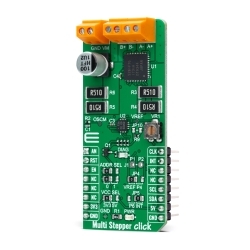
Stock and Customer Discounts
Available Discounts
- $24.65 | 25+ units
- $23.36 | 100+ units


